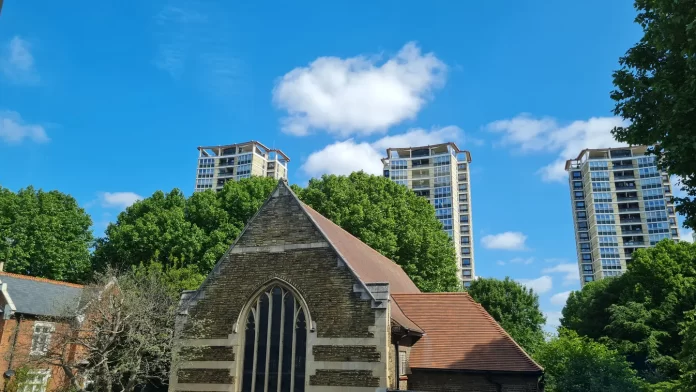Last Updated on January 8, 2024 by Umer Malik
Along with the Building Safety Act 2022, fire safety legislation for residential buildings continues to evolve. The Fire Safety Regulations 2022 came into effect on 23rd January 2023, and further changes are due later this year, including Higher-Risk Buildings Regulations due in April and a proposed Building Safety Levy still under consultation.
The new Fire Safety (England) Regulations focus on specific fire precautions for multi-occupied residential buildings, e.g. blocks of flats, and the measures that a designated ‘Responsible Person’ must take to protect people and property from fires.
Developers, owners, and managers of high-rise residential buildings should already be aware of the new regulations and be actively complying with them, but here is a summary of the guidance and how it applies, depending on the height of the multi-occupied building.
Table of Contents
Why were the new Fire Safety Regulations introduced?
In 2017, the Grenfell Tower tragedy revealed serious issues with fire safety in multi-occupied residential buildings in the UK. The Grenfell fire was the UK’s deadliest structural fire in almost 40 years, with the building’s improper cladding materials and an incorrect ‘stay put’ policy resulting in the preventable deaths of 72 people.
The inquiry into the tragic incident and a review into the safety of similar buildings led to multiple proposed changes for regulating how such buildings are constructed and managed, to ensure that residents could feel safe in their homes and be protected against fire safety risks.
The Fire Safety (England) Regulations 2022 have brought most of these recommendations into force, extending the legal responsibilities imposed by the Regulatory Reform (Fire Safety) Order 2005 (Fire Safety Order). Under Article 24, the new regulations impose stricter requirements on building owners and managers to mitigate fire risks for residents.
They specify essential precautions for a ‘Responsible Person’ to undertake, which may seem obvious, but Grenfell proved that these measures that should already have been standardised were not always implemented or followed.
The new regulations, therefore, encourage contractors and owners to appraise their fire safety measures more thoroughly and liaise with local fire and rescue services to ensure effective fire safety systems and operational responses.
Which buildings do the Fire Safety Regulations 2022 apply to?
The Fire Safety Regulations apply to all buildings in England that contain two or more domestic dwellings, including residential premises within mixed-use buildings, which contain ‘common parts’ that residents would use as an evacuation route in an emergency.
The regulations also cover student accommodation, but not maisonettes (where a flat exists within a converted property, with no common parts such as a main front entrance and staircase).
The updated regulations apply whether or not the flats are rented or subject to long leases, and regardless of whether or not the accommodation is used by the general public or a particular group of people (e.g. students or older people in sheltered housing).
They do not apply to the individual flats, other than measures connected to communal fire safety systems, such as smoke detectors, alarms, and sprinklers. Parts of these buildings that the regulations do apply to include:
- Communal corridors and stairways
- Flat entrance doors
- Walls and floors separating domestic premises from each other or other parts of the building in common use
- Non-domestic areas of the building (e.g. offices, laundry rooms, gyms, commercial premises)
- External walls (including doors or windows within them) and attachments (e.g. balconies)
The extent of the duties required depends on the height of the building, as some regulations apply to all buildings, and others apply only to taller buildings – as these are likely to contain more dwellings and have more restrictive building standards and firefighting tactics.
High-rise buildings, which are classified as 18 metres tall or higher, will have even stricter regulations coming into effect from 6th April 2023 – the Higher Risk Buildings (Key Building information Etc.) (England) Regulations 2023.
Who is responsible for Fire Safety Regulations 2022 compliance?
The person or party in charge of resident safety regarding the Fire Safety Regulations 2022 is known as the ‘Responsible Person’ – typically the building owner, landlord, or property manager.
The Fire Safety Order defines the Responsible Person as the individual person – or the organisation recognised as a ‘legal person’ – who controls the residential premises. As the definition is set out in the legislation, building owners or local enforcement authorities are not allowed to nominate a Responsible Person or delegate their compliance duties to another party.
In some cases, where a building has multiple uses, there may be more than one Responsible Person for different parts of the building. It is important for all parties to ensure that the Responsible Person is correctly identified so they can fulfil their duties under the new regulations. This includes, of course, keeping up to date with future regulatory changes.
What are the new duties of the Responsible Person?
The guidance for the Responsible Person clarifies the required duties for providing fire safety information to residents, carrying out fire safety checks of communal areas, providing appropriate evacuation signage, and maintaining records of the construction and design of the premises.
The extent of the responsibilities can vary depending on whether the building is a pre-existing or new construction, and how tall the building is. There are different categories for:
- General duties for all buildings with two or more domestic premises
- Duties for buildings with two or more domestic premises that are over 11 metres tall
- Duties for buildings with two or more domestic premises that are over 18 metres tall
As these regulations came into effect in January 2023, the identified ‘Responsible Person’ should already be complying with the following obligations for monitoring and maintaining fire safety.
Buildings up to 11 metres in height
In a multi-occupied residential building with two or more domestic premises, regardless of height, the Responsible Person is required to provide all residents with:
- Fire Safety Instructions – including guidance on how to report a fire and what residents should do if a fire occurs with a detailed evacuation strategy.
- Fire Door Information – including guidance on the importance of keeping fire doors closed when not in use, not tampering with self-closing devices, and reporting damage.
The fire safety instructions and fire door information must be presented in an easily understandable form, and both displayed in a conspicuous part of the building (such as a lobby or foyer) and provided in written form directly to residents as soon as they move in.
Additionally, copies of the fire safety instructions and fire door information must be reviewed and re-issued to all residents annually (every 12 months).
Buildings between 11 metres and 18 metres in height
In addition to the requirements above, the Responsible Person for such buildings above 11 metres tall must also conduct quarterly inspections of fire doors in common parts of the building, and annual inspections of flat entrance doors. These enhanced obligations cover:
- Communal area fire door checks (every 3 months) – doors to stairways and lobbies, cross-corridors, storage and electrical cupboards, and riser shafts for running various services.
- Flat entrance door checks (every 12 months) – access to flats must be granted to check the front door, and the steps taken must be recorded.
When checking both types of doors, the Responsible Person must ensure they are effectively self-closing or kept securely closed. The straightforward inspection should involve opening the door fully then letting it go, and opening it to around 15° and letting it go – the door should close fully into its frame on both occasions to be considered functional.
The Responsible Person should also look for any wear and tear to the door and its frame, including its seals, hinges, and any glazing or letterboxes. Where these checks identify defects, repairs must be carried out by a competent contractor as soon as possible.
Buildings exceeding 18 metres in height
On top of the two sets of requirements explained above, there are several much stricter requirements for residential buildings that are over 18 metres high (or 7 storeys tall or more). In this case, the Responsible Person must carry out the duties described below.
Provide floor plans and a building plan
If there is a fire in a high-rise building, floor plans and building plans help fire and rescue crews to assist with evacuations and determine appropriate firefighting measures. This is why the regulations require the Responsible Person to prepare a floor plan for each floor of the building and a building plan indicating its layout, key features, and surrounding environment.
The plans must identify the locations and layout of each residential premises, all lifts and stairways, and fire and rescue access points and equipment, including details of the following:
- Building environs (the building itself and its immediate surroundings)
- Building dimensions and number of storeys (including basement levels, if any)
- Building uses (e.g. residential or commercial parts)
- Building access points and stairways (including firefighting shafts, if any)
- Fire and rescue appliance access (e.g. inlets for wet rising mains and dry rising mains)
- Shut-off controls and central controls for sprinkler or smoke control systems
An electronic copy of these plans must be provided to local fire and rescue services, and a hard copy must be placed in the building’s secure information box (the location of which must also be detailed in the plans). If any changes are made, an up-to-date version must be provided as soon as possible.
Provide external wall construction information
The Responsible Person must provide a record of the building’s external walls to the local fire and rescue service, covering their design, materials, and the level of risk they pose (as per an official fire risk assessment mandated by the Fire Safety Order).
The record of information prepared must cover the following:
- An external wall design overview (including windows, doors, balconies, and fixings)
- Details of construction materials (including insulation and cladding)
- Any known defects in the external wall construction (previous or current)
- The risk level presented by the external walls and any attachments
- Any mitigating steps taken in respect of risks identified in the fire risk assessment
It’s crucial to provide high-level detail of practical value to the fire and rescue service’s pre-planning operations, as the front-line crews will need this information if there is a fire in the building. If any changes are made to the external wall system, another fire risk assessment should be carried out, and the record updated accordingly.
This information must be gained through a specialist appraisal, not a general inspection, and the Responsible Person is liable for arranging this. The standard code of practice for ‘fire risk appraisal of external wall construction and cladding of existing blocks of flats’ can be found in PAS 9980:2022.
Undertake routine checks of lifts and fire-fighting equipment
In a high-rise residential building, one lift or more should be designed for use by fire and rescue crews, enabling them to reach the upper floors in the event of a fire. There may also be further essential firefighting equipment throughout the building that these crews will rely on to fight the fire, such as access to dry or wet rising mains.
It’s vital for these systems to operate properly if there is a fire, so the regulations require the Responsible Person to carry out routine checks of all such equipment (in addition to the servicing and maintenance already required by the Fire Safety Order).
In addition to routine monthly checks of emergency service lifts and evacuation lifts, the Responsible Person should also oversee the carrying out of monthly checks on:
- Rising mains (wet and dry)
- Fire detection and alarm systems
- Fire suppression systems
- Smoke control systems
- Evacuation alert systems
- Automatic doors with opening/closing devices linked to fire detection/alarm systems
The Responsible Person must keep records of every monthly check, which must be accessible to the building’s residents if requested. If these checks identify a fault in any of the aforementioned systems or equipment, the Responsible Person must take immediate steps to rectify it.
If any piece of essential firefighting equipment is out of action for more than 24 hours, it’s the Responsible Person’s duty to electronically notify the local fire and rescue service of the defect, and to update them when the fault has been fixed.
Install and maintain a secure information box
All of the information relating to the building’s fire safety, including the floor plans, building plan, external wall information, and contact details for the building’s Responsible Person, should be provided in a hard copy that is stored in a secure information box on the premises.
This box must be installed in a location that is easily accessible to the fire and rescue service, yet also be secure against unauthorised access and vandalism. A secure information box will typically have a lock that can only be opened by a key that is carried by fire and rescue services and has legal protection against key copying.
The Responsible Person must provide the local fire and rescue service with the necessary information to access the secure box, and must inform them as soon as possible if there are any changes to these access details or the information stored in the box.
The box must be inspected annually to maintain its security and accessibility for the fire and rescue service. The information within should also be checked annually to ensure that it remains accurate, and should be updated if necessary.
Install highly visible wayfaring signage
Due to the height of high-rise buildings increasing the number of floors and residences, it’s crucial to have accurate signage throughout the premises to help fire and rescue crews with orientation if they enter the building when there is a fire.
This signage should already have been included with the completed building if it was designed from November 2020 onwards, in order to comply with new Building Regulations. However, the Responsible Person for older buildings may be required to check and update wayfaring signage.
This signage should clearly indicate the floor number and flat numbers on that floor, and be immediately visible upon the lift doors opening on each floor. This should be present in the appropriate stairways and hallways, and all signage should be highly visible even in low light or smoky conditions.
Of course, all wayfaring signage should also be checked regularly and maintained, which can be done during other legally required inspections within the building. Specifications for the typeface, size, mounting height, and wording of such signage can be found in Approved Document B of the Building Safety Regulations.
Construction sector compliance with Fire Safety Regulations
Overhauls in building safety management, including fire safety, have led to a turbulent time for the construction industry in recent years. There is also a lot of pressure to adopt digital processes for maintaining records and sharing information, creating a ‘golden thread’ of accountability.
There’s no doubt that it’s essential to follow all regulations and help fire and rescue services to prepare informed responses for emergency scenarios – non-compliance means putting lives at risk and receiving high financial penalties, which simply isn’t worth it.
When constructing new buildings, it’s best to keep on top of the very latest regulatory changes, to ensure that the property will be completed to the highest possible safety standards at the time. One way to do this is to arrange structural inspections at key stages through a building warranty, alongside inspections by the local building authority.
A building warranty protects the owner’s financial investment into the building in the event of latent structural defects developing, which can be costly to repair – especially in multi-storey residential buildings. Of course, building owners should also be sure to set up appropriate building insurance policies for financial support in case of fire damage, as residents should for contents insurance to protect their personal belongings.More detailed information on the Fire Safety (England) Regulations 2022 can be found on the UK government website for further consultation.
Apart from that, if you are interested to know about New Asset Class for Passive Investors then visit our Real Estate category.
















